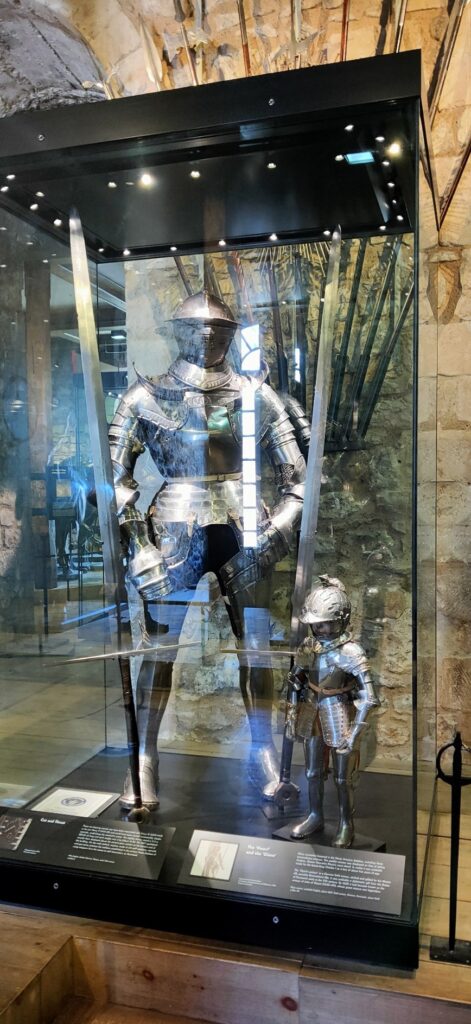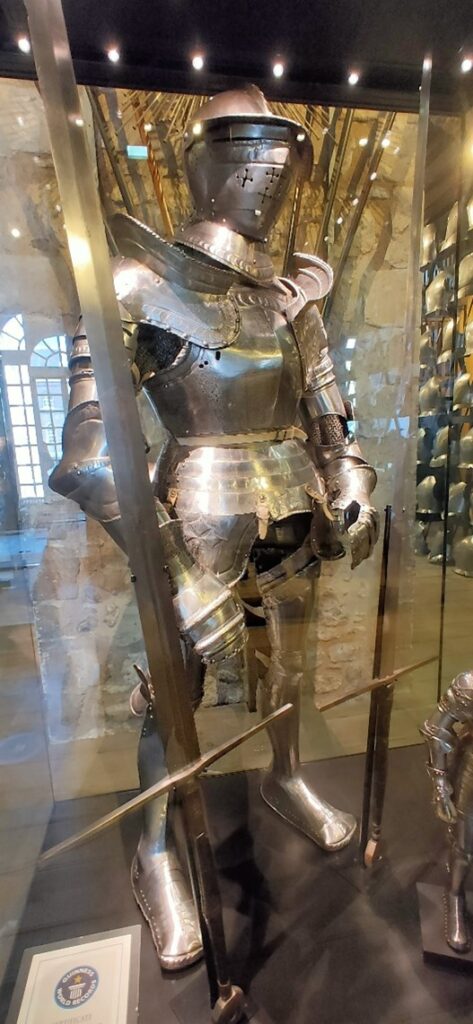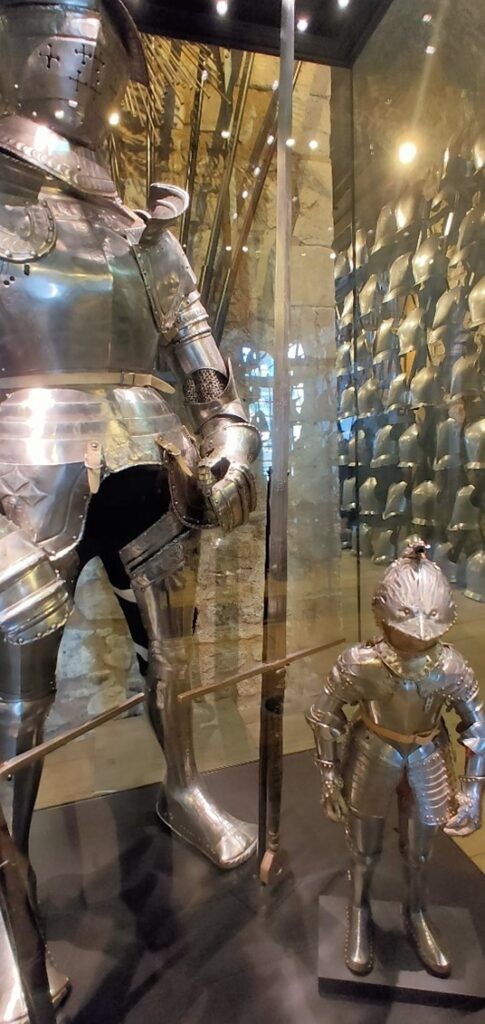


Even without the bling, these swords are impressive. The so -called Giant’s Armour (II.22) stands over 6 feet 9inches tall, overshadowed by these bearing swords.
The downside of displaying a sword is that they are by their nature rather slim and straight – they can all too easily get lost among other objects and backdrops. Ideally, they are best viewed close up and hands on. There is nothing like the feel of a good medieval sword in the hand, even if it’s in an excavated or decayed state. Their balance is such that they sing in your grip – there’s no other way to describe it.
Penny Mordaunt’s appearance at the Coronation has drawn much comment on social media – not only as an impressive physical feat, but also for breaching the previously boys-only club of sword bearing. Three cheers! And unlike the lady of the lake, she didn’t have to do it holding her breath.
Personally, while I respect the symbolism of the swords carried at the coronation and am happy to see them have their moment in the limelight, there are more impressive examples of the genre. If you go to the Tower of London please don’t overlook viewing two equally majestic and much older bearing swords. They are hidden in plain sight in the White Tower, on the East side of the entrance floor, inventory numbers ix.1024 and 1025.
They don’t have the velvet scabbards of their regalia counterparts, or the Sword of State’s fussy gold cross-guard with lion and unicorn exploding from the quillon block. It is unfortunate that the latter’s horn is angled as it appears to have become. And while I like bling hilts as much as anyone, the be-jewelled grip of the Sword of State is neither practical or particularly attractive. The Armouries’ pair of stark, plain steel bearing swords command attention, even behind glass, and at approaching eight hundred years old and almost 7.5 feet long, knock their seventeenth- and eighteenth-century cousins into a cocked hat, plumed as it may be.
They are potentially fighting weapons, but their greater size suggests that they were intended primarily as bearing swords, associated with the Lancastrian kings Henry IV (1399-1413) and his son Henry V (1413-22). In an age of limited media opportunity and literacy, symbolism was well understood, and these strapping two-handers would have commanded attention and cleared a path simply carried upright in a procession. The marks on their tapered blades were probably originally inlaid with copper or brass. The narrow groove or fuller running from the hilt along half their length retains the blade’s integrity while practically lightening it. They also carry a sleek stylised wolf mark, signifying their German origin. Nothing but the best. Unusually, the swords retain their wooden grip and leather covering, and the weight of the sixty-six-inch blade is balance by a significant octagonal pommel.
Weighing something over 14 lbs carrying them would require skill and practise. As embodiments of power and reminders that with authority comes responsibility, I would argue they are at the heart of the Tower Armouries collection. Historic guidebooks don’t make a song and dance over them, and they may even have been lent out of the Tower at one stage as so many of the historic weapons were, but they retain a self confidence that only an elegant, well balanced medieval sword commands.
Traditionally plain old iron protected against witches, evil spirits and ghosts, adding no doubt to their potency when crafted into a sword blade. History is about the manipulation of power and swords present a very hands-on symbol of this, embedded in popular culture as far more than simply a means of destruction. Such simple cross-hilted swords as these need no further embellishment – they deliver what they promise without compromise. They also act as a trigger to remind us of the importance in a knight’s training of more than just weapons’ skills. Grounding in manners, courtesy and, as in all martial arts, self-discipline were core parts of that education from its beginning. To carry a blade brought responsibility towards others and correct and controlled usage. Our forefathers weren’t stupid recognising that unbridled sword fighting cut into the population faster than it could regenerate itself. Respect for weapons and for one’s fellows go hand in hand.
So, having gorged on the sparkly bits in the Crown Jewels display at the Tower of London, make sure to look out these real cutting-edge swords in the White Tower. Perhaps History should take a leaf out of Justice’s book and start carrying her own swords.
For more information on IX.1024 and 1025, please follow this link:
https://collections.royalarmouries.org/#/objects?search=%22ix.1024%22&sort=relevance
